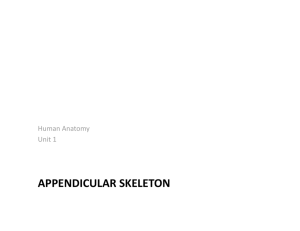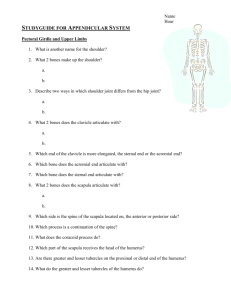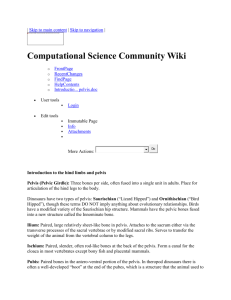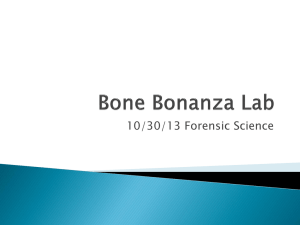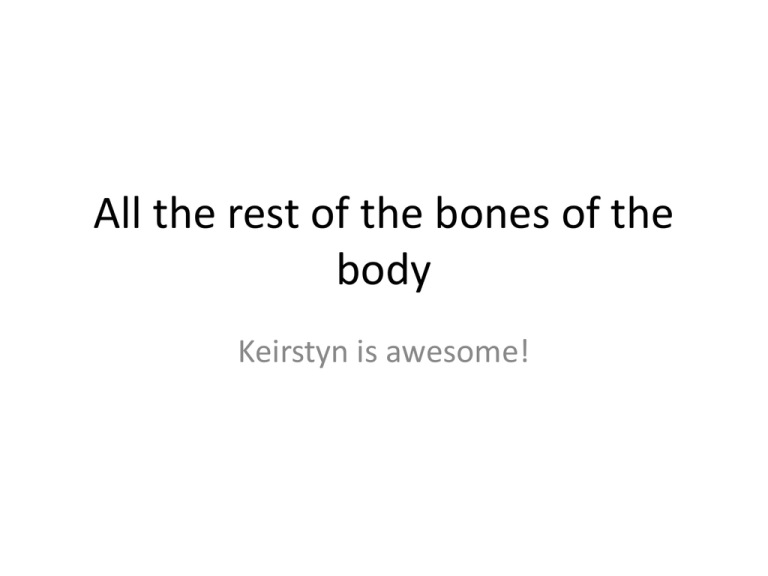
All the rest of the bones of the
body
Keirstyn is awesome!
Pectoral girdle
Pectoral girdle:
Clavicle:
•s-shaped, horizontally above 1st rib
• medial end joins with sternum
•Lateral end joins with acromion of the scapula
•Function:
Scapula:
•Lg, flat, triangular bone
•Spine runs diagonly across posterior surface
of body
•Lateral end of spine = glenoid cavity
Caracoid process:
Humerous
•Longest bone of upper limbs
•Head @ proximal end
•Anatomical neck = site of epiphyseal
plate
•Body contains V-shaped area called
deltoid tuberosity
•Distal end; capitulum; rounded knob
joins with head of radius
•Radial fossa recieves head of radius when
you flex
•Trochlea; spool-shaped joins with ulna
•Coronoid fossa: recieves ulna when
forearm is flexed
•Olecranon fossa: back of bone, recieves
olecranon of ulna when forearm is
straightened.
Ulna and radius
--radial tuberosity
•Little finger side
•Longer than radius
•Olecranon process froms prominence of elbow
•Olecranon process and coronoid process and
trochlear notch receive the trochlear of humerous
•Radial notch fit the head of the radius
Radius:
•Thumb side
•Head joins with capitulum of humerous
and radial notch
•Radial tuberosity provides pt of attchment
for bicep brachii muscle
•Distal end joins with 3 carpal bones
Carpals
•Held together by ligaments
•Named for their shape
•Concavity formed by the pisiform
and hamate; scaphoid and trapezium make
a space called the carpal tunnel
Metacarpals
Each consists of a base, distal head
B
O
D
y
base
Phalanges
•14 bones in each hand
•1 bone = phalanx
•Consist of base, body, head
Pelvic girdle
-----sacroiliac joint
•Consists of 2 hip bones (coxal bones)
•Functions:
1. Support for vertebral column
2. Protect pelvic viscera
3. Attach lower limbs to axial skeleton
• United in front at pubic symphysis
• United in back with sacrum at sacroiliac joint
•All 3 bones together = pelvis
-------------pubic symphysis
Pelvis continued
•Divided into upper and lower portions by pelvic brim
•Upper = false pelvis
•Part of abdomen
•No pelvic organs except urinary bladder
and uterus
•Lower = true pelvis
•Upper opening pelvic inlet
•Lower opening pelvic outlet
•Pelvic axis – imaginary curved line
passing through the true pelvis
•Course taken by babies head
Pelvic axis
Hip bones
•Iliac crest:
•Greater sciatic notch:
•Deep fossa:
•Acetabulum:
•3 bones – ilium, pubis, ischium unite
by age 23
•Obturator foramen:
Femur
•Longest, heaviest, strongest bone
•Bends medially, causing the knee joint
to be nearer the midline of the body
more medial in women, since pelvis is
broader
•Greater trochanter: pt of attachment
for some thigh and buttock muscles
•Lateral and medial condyle: join with
tibia
•Between them is patellar surface
Patella
•In front of the joint between the femur and tibia
•Developes in the tendon of the quadriceps femoris
muscle
•Functions:
1.
2.
3.
•During normal flexion and extension the patella glides up and down in the grooves
between the 2 condyles
Tibia and fibula
•Tibia: larger medial wt bearing bone
•Joins with below knee
•Fibula: smaller and lateral than tibia
•Pt of attachment for patellar ligament
•Joins with talus of ankle
Tarsals
•Talus-only bone of foot to join with tibia and fibula
•During walking it initially bears the entire body wt
•½ wt is then transferred to the calcaneus
•Remainder is transferred to other tarsal bones
•Calcaneus-largest, strongest of the tarsals
Metatarsals
•Numbered I-V medial-lateral
•Consist of base, body, head
•1st metatarsal is connected to the big toe is thicker
because it carries more wt
Phalanges of foot
•Hallux (big toe) has 2 lg heavy phalanges; proximal, distal
•Other 4 have 3 phalanges, proximal, medial, distal
Arches of the foot
•Functions:
1
2
3.
•Are not rigid
•Yield as wt is applied, spring back when
lifted
Male vs female skeleton
•Male skeleton:
1.
2.
3.
•Female skeleton:
1.
Skeletal system and aging
• Birth – adolescense more bone produced than
lost
• Young adults bone production = loss
• Middle age level of sex steroids < (more in
women after menopause) = loss of bone mass
– Bigger problem in women
• Bones become more brittle
– Due to < in rate of protein synthesis and HgH
Continued
• Females: loss of bone mass begins at 30 and
accelerates at 45 as estrogen levels <
– 8% bone mass lost every 10 years
• Males: loss of bone mass begins around age
60
– 3% bone mass lost every 10 years


